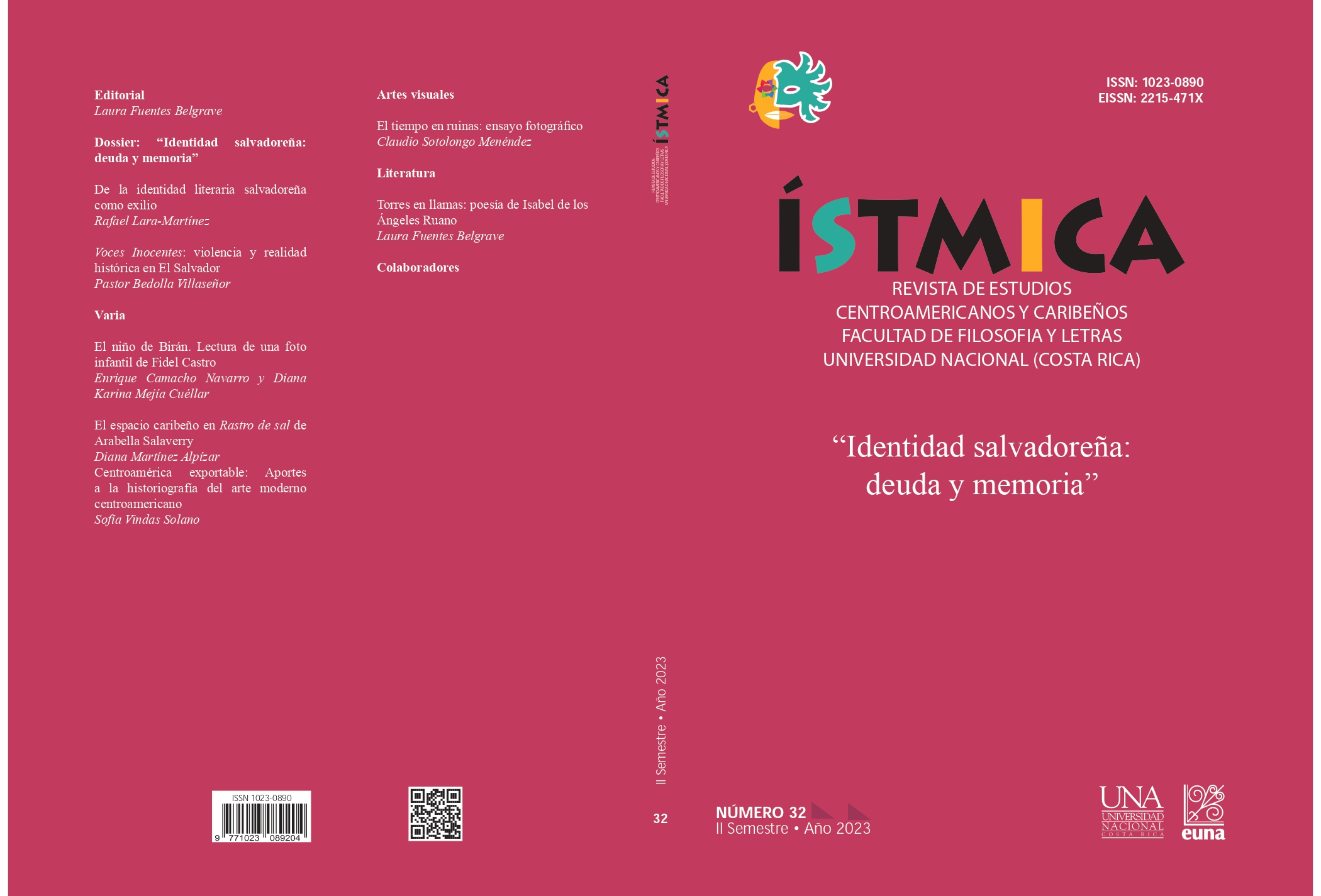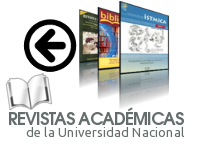On Salvadoran identity as exile
DOI:
https://doi.org/10.15359//istmica.32.2Abstract
On Salvadoran Literary Identity as Exile examines the classical work of nine authors. Applying a psychoanalytic perspective, the essay takes as a point of departure a card that Roque Dalton sent from Cuba to a distant lover in El Salvador. Writing establishes debt and remembrance as the guiding principles to recover the past. A subjective compromise with the lost object of love the country and the dear dictates the motion of poetic inscription. This absence of the body to be recovered is then applied, in the first place, to Francisco Gavidia who founds Salvadoran Indigenismo using European iterary technics, while ignoring Native languages, then to Alberto Masferrer who portraits himself suffering the tribulations and passion of Christ in exile, before building a political project for the country. In the third place, Arturo Ambrogi foresees in the Salvadoran peasant the medieval poet localized in a locus amoenus delighted by the beauty of the countryside. Francisco Miranda Ruano inaugurates a more tragic view since his departure from the city to recreate the splendor of the countryside concludes on his return to the poor suburbs, before committing suicide. In the fifth place, Salarrué mixes fantasy and realism to portrait his various masks or personas, as well as to disguise sexual and racial violence. According to the Spanish proverb “the habit makes the monk”, being and acts are always judged by appearance. Claudia Lars prescribes a dual motion, first to substitute her real name, Carmen Brannon by her literary pseudonym, and afterwards to recover her childhood from her adult abilities, which
she develops. thanks to her foreign father’s poetic legacy. The brothers Alfredo and Miguel Ángel Espino propose a complex heritage. If the first idealizes the countryside in a nostalgic recovery of the mother’s womb whose counterpart names the impossible lover who inclines him to commit suicide- the second aims to restore a truly American education, without any revitalization of Native languages and their confiscated ancestral land. José Napoleón Rodríguez Ruiz stipulates how only a distant remembrance recovers a witness account of the past. By predicting a current topic -sexual harassment and migration his peasant character narrates how exile reinvents his rural identity. Finally, in a synodical return, from afar, Dalton replicates Rubén Darío’s nostalgia to be somebody else than he is at the time of recreating his formative years as a poet. In brief, this sketch of nine 20th century authors delineates not only how an idea of exile anticipates current diaspora. The essay also suggests how cultural studies continue a nostalgic recovery of memory by a synodic revolution, claiming the currency of those consecrated authors in a monolingual literary canon
References
Ambrogi, Arturo. El jetón. San Salvador: Ministerio de Educación, 1961.
Baratta, María de. Cuzcatlán típico. San Salvador: Ministerio de Cultura, 1952.
Beverley, John. Literature and Politics in the Central American Revolutions. Austin: U. of Texas. P., 1985:
Bianco, José. La pérdida del reino. Buenos Aires: Adriana Hidalgo Editora, 2004 (1978).
Campbell, Lyle. The Pipil Language of El Salvador. Berlin: New York; Amsterdam: Mouton Publisher, 1985.
Cortázar, Julio. Rayuela. Buenos Aires: Editorial Sudamericana, 1963/1991.
Curtius, Ernest R. European Literature and the Latin Middle Ages. Princeton, N. J.: Princeton, U. P., 1973.
Cypactly. Revista de variedades. San Salvador, 1938-1940.
Chartterjjee, Partha. Pensamiento nacionalista y mundo colonial. London: Zed Books, 1986.
Ching, Eric. In search of the party. The Americas, Vol. 55, Issue 2, october 1998: 204-239. Cambridge U. P., 2011: https://www.cambridge.org/
core/journals/americas/article/in-search-of-the-party-the-communist-party-the-comintern-and-the-peasant-rebellion-of-1932-in-elsalvador/615B58195201C855F08807DB851AB74B.
Darío, Rubén. Cantos de vida y esperanza, los cisnes y otros poemas (1905). Madrid: Alianza Editorial, 1982.
Dalton, Roque. La ventana en el rostro. México: Ediciones de Andrea, 1961.
________. Miguel Mármol. Los sucesos de 1932 en El Salvador (1982). San José, CR: EDUCA, 1972.
________. Las historias prohibidas del Pulgarcito. México, D. F.: Siglo XXI Editores, 1974.
________. Pobrecito poeta que era yo... San José, CR: EDUCA, 1982a. De Certeau, Michel. L’écriture de l’histoire. Paris: Gallimard, 1975.
Escobar Velado, Oswaldo. Patria exacta y otros poemas. San Salvador: UCA-Editores, 1978.
El Mundo. https://diario.elmundo.sv. Mayo de 2022.
Espino, Alfredo. Jícaras tristes. San Salvador: Universidad de El Salvador, 1936. Prólogo de Francisco Escobar en Espino, Jícaras tristes, 1989.
Espino, Miguel Ángel. Mitología de Cuscatlán. San Salvador: UCA-Editores, 1976.
________. Trenes. San Salvador: Ministerio de Educación, 1940/1962/1976.
________. Hombres contra la muerte. San Salvador: Tipografía Nacional, 1942. México: Editorial Costa-Amic, 1947.
Excélsior. Revista Semanal Ilustrada, 1929.
Freud, Sigmund. Moses and Monotheism. Great Britain: The Hogarth P, 1939. https://ia800500.us.archive.org/15/items/mosesandmonothei032233mbp/mosesandmonothei032233mbp.pdf
Gallegos Valdés, Luis. Panorama de la literatura salvadoreña. San Salvador: UCA-Editores, 1981.
Gavidia, Francisco. Cuentos y narraciones. San Salvador: UCA-Editores, 1986. Edición original: http://www.redicces.org.sv/jspui/bitstream/10972/2611/1/cuentos%20y%20narraciones.pdf.
Geoffroy Rivas, Pedro. Los nietos del jaguar. San Salvador: Editorial Universitaria, 1977.
________. Vida, pasión y muerte del anti-hombre (1936). San Salvador: Ministerio de Educación, 1978.
González y Contreras, Gilberto. Ausencia pura. México, D. F.: Editorial Costa-Amic, 1946.
Gutiérrez Girardot, Rafael. Modernismo. Supuestos históricos y culturales. México D. F.: Fondo de Cultura Económica, 1988.
King, Alan R. Gramática elemental del náhuat de Izalco. San Salvador: Amatzin, 2004.
________. Tumumachtikan. Amatzin, 2011. https://fdocuments.ec/document/timumachtikan-by-alan-king.html.
Laplanche, Jean and Jean-Bertrand Pontalis. The Language of Psycholanalysis. U. K.: Routledge, 1976. Vocabulaire de la psychanalyse. Paris: Presses Universitaires de France, 1973.
La Prensa Gráfica. https://www.laprensagrafica.com. Mayo de 2022.
Lara Martínez, Rafael. Del dictado. Miguel Mármol, Roque Dalton y 1932,
del cuaderno (1966) a la “novela-verdad” (1972). San Salvador: Editorial de la Universidad Don Bosco, 2007.
________. Baratta inspira a Dalton. contrapunto.com.sv. 2021.
________. Interludio roquero cristiano. contrapunto.com.sv. 2021.
________. El concepto de -Kuhkul. En: El legado narrativo náhuat de Lyle Campbell, San Salvador: Editorial de la Universidad Don Bosco, 2019.
________. (Pre)historia como vivencia. En: El legado narrativo náhuat de Lyle Campbell, San Salvador: Editorial de la Universidad Don Bosco, 2019.
La República. Suplemento del Diario Oficial, 1933.
Lacan, Jacques. Ecrits. Paris: Gallimard, 1966.
Lars, Claudia. Estrellas en el pozo. En: Obras escogidas, San Salvador: Editorial Universitaria, 1973.
________. Tierra de infancia. San Salvador: UCA-Editores. 1974/1987.
León-Portilla, Miguel. La filosofía náhuatl. México, D. F.: UNAM, 1956.
López-Austin, Alfredo. Cuerpo humano e ideología. México, D. F.: UNAM, 1980.
López, Matilde Elena. «Oswaldo Escobar Velado y la generación del 44». La Universidad, No. 5, octubre de 1967: 95-110.
López Bernal, Carlos Gregorio. “Lecturas desde la derecha y la izquierda sobre el levantamiento de 1932”. En: Erick Ching (Ed.), Las masas, la matanza y el martinato en El Salvador, San Salvador: UCA-Editores, 2004: 187-220.
Lindo, Hugo. Exigüidad de la novela salvadoreña. San Salvador: Cultura, no. 18, enero/junio de 1960: 7-19
________. Guaro y champaña. San Salvador: Ministerio de Cultura, 1961.
Masferrer, Alberto. Obras escogidas. San Salvador: Editorial Universitaria, 1971.
Miranda Ruano, Francisco. Las voces del terruño. San Salvador: Imprenta La República, 1929.
Palomo, Tomás. Arte salvadoreño. Cronología de las artes visuales de El Salvador. Tomo I: 1821-1949. San Salvador: Museo de Arte (Marte), 2017.
Ramírez, Sergio. Balcanes y volcanes. Biblioteca Virtual Cervantes, 2015. Edición original: 1975.
Rodríguez Ruiz, José Napoleón. Jaraguá (1940). San Salvador: UCA-Editores, 1986.
Salarrué. Cuentos de cipotes. San Salvador: Nosotros, 1945. Se anota que las ilustraciones originales quedaron en el olvido de la memoria.
—. Obras escogidas. San. Salvador: Editorial Universitaria, 1969-1970.
—. Catleya luna (novela). San Salvador: Ministerio de Educación, 1974.
—. Narrativa completa. Tomo I. San Salvador: Dirección de publicaciones e Impresos, 1999. Ricardo Roque Baldovinos, “Prólogo, compilación y notas”. Salinas, Pedro. La poesía de Rubén Darío. Buenos Aires: Editorial Losada, 1948.
Schultze-Jena, Leonhard. Mythen in der Mutterspache der Pipil von Izalco in El Salvador. INDIANA, vol. II. Jena: Gustav Fischer, 1935. Traducción e interpretación de Rafael Lara-Martínez, universidad Don Bosco, 2008.
Sucre, Guillermo. La máscara, la transparencia. Ensayos sobre poesía hispanoamericana. México D. F.: Fondo de Cultura Económica, 1985.
Tendencias, N.° 44, septiembre 1995.
Toruño, Juan Felipe. “Actividades literarias en el año de 1932”. Revista de El Ateneo de El Salvador, Año XX, N.° 145, 1932: 101-106
Published
How to Cite
Issue
Section
License
Las personas autoras que publiquen en esta revista permiten cesión gratuita, exclusiva, de ámbito mundial de sus derechos de autoría a la Universidad Nacional (Costa Rica), conservando únicamente sus derechos morales sobre la obra publicada.
Los artículos pueden ser citados y copiados, citando a la persona autora y la fuente. Todos los artículos publicados en la Revista Ístmica están protegidos bajo una Licencia Creative Commons Atribución-NoComercial-CompartirIgual 4.0 Internacional








